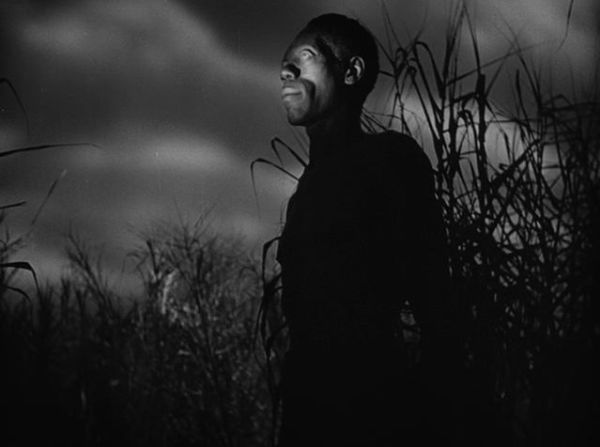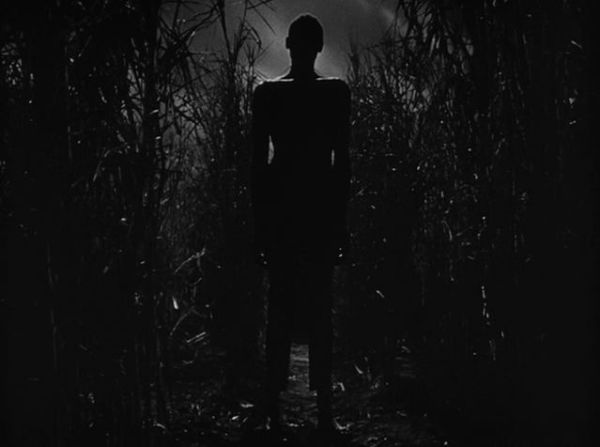 After Cat People, producer Val Lewton and director Jacques Tourneur worked together again on I Walked with a Zombie (1943). Despite its even more lurid title, Zombie is less of a horror film than Cat People, though it occupies a very similar territory of dark psychology and the supernatural.
After Cat People, producer Val Lewton and director Jacques Tourneur worked together again on I Walked with a Zombie (1943). Despite its even more lurid title, Zombie is less of a horror film than Cat People, though it occupies a very similar territory of dark psychology and the supernatural.
The film starts with young Betsy Connell being taken on as a nurse to Mrs Jessica Holland on the island of St Sebastian in the Caribbean. Apart from bouts of sleepwalking, Jessica is almost catatonic, and it’s later revealed that her illness began just as she was about to run away from the island with her lover, her husband’s half-brother, Wesley Rand. Having fallen for Mrs Holland’s strong, silent type of a husband, nurse Betsy tries everything she can to cure Jessica, and when the latest medical methods fail, takes her ghostly charge to the local voodoo cult, who of course recognise her as one of their own. As someone says of her: “She makes a very beautiful zombie.”
Where Cat People’s Irena was a foreigner bringing her wild, foreign darkness to the shores of civilised modern America, I Walked with a Zombie’s Betsy is a Canadian, who journeys into the wild, foreign darkness of St Sebastian’s highly-charged atmosphere of repression, betrayal, jealousy, bitterness, resentment, beauty and death, love and mental illness, and willingly becomes caught in its emotional tangles: while Paul Holland, “strong, silent and very sad”, whose first words are to inform Betsy that the supposedly beautiful phosphorescent lights in the sea are caused by things dying (“There’s no beauty here, only death and decay. Everything good dies here, even the stars.”) — and the fact that he chooses to hang a copy of Böcklin’s Isle of the Dead in his sick wife’s bedroom probably says a lot about his state of mind — bears the burden of his wife’s malady like a family curse, his half-brother Wesley teeters on the verge of alcoholism, and his otherwise level-headed mother keeps the extent of her dabblings in the local voodoo cult secret. In both films, troubled souls are failed by the latest advances in Western medicine (psychiatry in Cat People, insulin shock therapy in Zombie), but only because the cause of the malady is supernatural: Irena really does turn into a panther, Jessica really is a zombie.
But the main difference, what makes Cat People a tragedy and this a Gothic romance (as Kim Newman and Stephen Jones point out in the DVD commentary, it’s basically Jane Eyre with voodoo) is perhaps its attitude to the supernatural. Here, far from the civilised streets of Cat People’s New York, the lines between what should be believed and what shouldn’t are blurred, and it is the practical-minded Betsy’s willingness to take a walk into the twilight realm of the voodoo “home fort” (a nightmare journey fraught with spookiness, and the film’s high point) that separates her from the ultimately censorious and condescending attitudes of Cat People’s Alice, Ollie and Dr Judd.
I Walked with a Zombie is not so much a horror film as one dripping with a very shadowy Gothic. And it takes a surprisingly un-sensationalist approach to voodoo, neither presenting it as an excuse to wallow in lurid shock imagery, nor as a Hollywood cliché of “native superstitions”. A good, ghostly-tinged film, then, probably better in terms of characterisation and drama than Cat People, though I have to say I still prefer Cat People for being so intense, weird, dark and tragic.




I must check this particular trilogy out! It’s interesting that you mentioned how the story mimics ‘Jane Eyre’ as Jean Rhys wrote a novel (‘The Wide Sargasso Sea’*) an alternative backstory of Mr Rochester’s mad wife in which she’s a white creole and a native of the Caribbean.
* you may well have heard of it, but just in case you haven’t….
I had heard of it, but didn’t make the connection. Mind you, I haven’t read Jane Eyre, either!
Neither have I! As a result, that aspect of the ‘Wide Sargasso Sea’ (ie, as a commentary on ‘Jane Eyre’) was all a bit wasted on me.
Mind you, it says something about a book if you enjoy it still while not having read the book it refers to. (assuming you enjoyed it!)
Well it was beautifully written and it really does give you a sense of a time and a place (Rhys grew up in the Carribean). I’m not sure I would have cared had I known (I only found out later on).